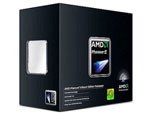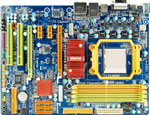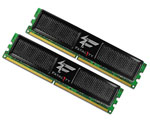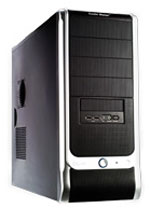AMD Budget
Leaving the entry-level sector behind and with a budget of under $800, our options increase significantly. Our aim here is to provide a configuration that allows for a nice balance of performance at stock speeds. This doesn't mean you have to spend over $800 though, as prices have dropped in the past year and performance for the dollar has definitely increased. Both budget systems are under $800 complete, with the basic box under $500 in both cases. This gives you the option to increase graphics power or go for a larger monitor (or both) and still be less than $1000. The assembled system is balanced for a wide variety of computing tasks, but final tweaks can tilt it toward gaming and graphics for example, if that is what you aim for.
Generally we consider PC Gaming rigs to begin at the next price category (i.e. the low end of midrange), but adding a decent graphics card and a larger monitor will definitely make one of these budget systems a good choice for entry gaming at around $1000. If that is your goal take a look at the Phenom II Guide for help in selecting a graphics card and display for your price point.
| AMD Budget PC | ||
| Hardware | Component | Price |
| Processor | AMD Phenom II X3 720 BE (2.8GHzx3, 3x512KB L2, 6MB L3 Cache) |
$145 |
| Cooling | CPU Retail HSF | $- |
| Video | On-Board | $- |
| Motherboard | Biostar TForce TA790GX3 A2+ | $110 |
| Memory | OCZ Fatal1ty Edition 4GB DDR2-1066 OCZ2F10664GK ($28 after rebate) | $43 |
| Hard Drive | WD Caviar GP WD5000AACS 500GB | $59 |
| Optical Drive | Samsung 22X DVDRW/DL SH-S202G | $25 |
| Audio | On-Board | $- |
| Case | Cooler Master Elite 330 RC-330-KKN1-GP Mid Tower | $40 |
| Power Supply | BFG Tech LS Series LS-550 550W SLI Certified, CrossFire Ready, 80 PLUS Certified ($20 Rebate) | $60 |
| Base System Total | $482 | |
| Display | ViewSonic VX2233wm Black 21.5" 5ms Widescreen 16:9 LCD (1920x1080) | $170 |
| Speakers | Logitech R-20 12 Watts RMS 2.1 Multimedia Speaker | $18 |
| Input | Microsoft CA9-00001 Black PS/2 Standard Keyboard and Optical USB/PS2 Mouse - OEM | $16 |
| Operating System | Microsoft Vista Home Premium OEM | $99 |
| Complete System Bottom Line | $785 | |
 |
While the GPU is the most important factor in game performance, the CPU is also a factor. To make sure the CPU is not a bottleneck now or in the near future should you upgrade your budget PC, a Black Edition Phenom II X3 is the CPU choice. The Phenom II 720 Black Edition has an unlocked multiplier should you choose to overclock, which makes overclocking as simple as it gets. It is rated at 2.8GHz with 3x512KB L2 cache, and 6MB of L3 cache. As a 45nm Phenom II it is also a dynamite overclocker - in fact it is the same CPU we recommended in our Phenom II OC system just a few weeks ago.
 |
We've paired the Phenom II 720 BE with the Biostar TForce TA790GX3 A2+, a perfect match for those looking to squeeze as much performance out of their money as possible. The Biostar is loaded with overclocking features and features integrated AMD HD 3300 graphics with an HDMI/DVI interface and 1080P support. This means very decent performance using the onboard graphics. Biostar offers both AM2+ and AM3 CPU support for processors like the Phenom II 720BE when used with cheaper DDR2 memory. Biostar includes 128MB DDR2 sideport memory for improved GPU performance, Realtek ALC 888 HD Audio codec, Gigabit LAN, 16GB memory support, six 3Gb/s ports capable of RAID 0/1/10/5, 10 USB ports, two PCI-E x16 slots (dual x8 CF), two PCI-E x1 slots, and two PCI slots. The BIOS caters to the casual overclocker and this board performs very well in a variety of tests.
 |
We've chosen OCZ Fatal1ty Edition 4GB DDR2 1066 (PC2 8500) in a 4GB kit for $43. This is a great value in DDR2-1000 memory from a top memory supplier. Right now it's an even better deal with a $15 rebate that lowers your net price to $28. The extra 1066 speed lets you run your memory at a faster speed or provide reserves for overclocking the CPU. OCZ is a great memory choice, but there are many memory options at great prices today. Quality DDR2-800 and DDR2-1000 RAM from Corsair, OCZ, G.Skill, Mushkin, and Geil are available at any of the major online retailers. Just be sure to look for RAM with better timings if you can afford it.
The remaining components are the same as our entry systems. The hard drive remains a 500GB Western Digital. If you'd prefer a longer warranty, look at Seagate, which includes a 5-year warranty on some of their drives for a few dollars more. The DVD burner remains the same Samsung 22X.
 |
The case receives an upgrade with the selection of the Cooler Master Elite 330 and our AnandTech Gold Editors Choice BFG Tech LS Series LS-550 550W power supply. The BFG currently has a $20 rebate which reduces the final cost to $60. The BFG 550W is a great power supply, but you could save a few dollars here with an OCZ, Corsair, or PC Power and Cooling PSU, which are often on rebate in recent months. It all depends on the timing of your system purchase.
 |
The LCD display was an easy choice with the full HD high resolution Viewsonic 22" 16:9 widescreen for just $170. A 21.5" monitor with 1920x1080 resolution with a 3-year warranty from a major monitor maker is certainly a good value. If you prefer a larger screen you can find a 24" widescreen starting at $250, though most are $300 or more. If you need to save a few dollars a lower resolution 19" or 20" would do.
 |
If you want more video power for gaming you can add an ATI HD 4830 for just $75-$90. This will get you into gaming and it is a terrific value at this price according to our Graphics Editor. He recommends the Radeon HD 4850 as the start of true HD gaming starting at just $120 or a Radeon HD 4870 512MB which you can find for as little as $155. Any of the three cards would still keep your total well below $1000. The 4870 addition totals just $940 for an extremely capable 1920x1080 system complete with a Viewsonic 1080P monitor.










66 Comments
View All Comments
v12v12 - Wednesday, March 18, 2009 - link
I agree most of these posts are the nerds-nit-pick special! I'm sorry but if you're whining about $15 here and $20, get a clue and get a REAL JOB or start saving/studying for certs/school and make some real money.This shoe-string budget crap, for a so-called "gamer" box is plain stupidity. If you're hurting over $600-800 MAX limit, sounds like you have your financial PRIORITIES out of whack! Nobody is "gaming" for long with a $600 box. It's a fool's investment and will have you stuck with a sub-par performing machine, rapidly. Oh and don't even think about resale, you're stuck with the low-end junk.
While mirroring the car market: UPSCALE cars/PC builds lose a small percentage of value as soon as you buy them, BUT they hold top value over the coming months Vs this low-mid-level junk that immediately loses an chance of resale value. Have you seen how many stupid people are on Ebay that overbid even for those relic 8800s?!
Who's going to buy your used, non-warranted (many manu's do require proof of purchase these days) 2nd rate card for ~$30 less than RETAIL? Pawning that off to ebay noobs is your only hope to recoupe your losses. Be smart people.
If you're maxing out around $600 = STOP and rethink your finances... $800? Might as well save and get an Icore. Geesh, oh and don't forget about TAXES + initial cost of hardware lol. Not to mention if something goes wrong and you have to RMA = how you gonna afford S/H if you can barely afford a paltry $600-800?
Flame time...
nubie - Tuesday, March 17, 2009 - link
I did get an e5200, for $59.But the motherboard I chose was not using single channel ram, or onboard video. I got an 8600GTS (the GTS is important, it has much more memory bandwidth - 2000mhz DDR3) for $43.
I would like to note that new systems with any sort of budget should be built with a quad-core (unless you need that 4.0ghz clocked Wolfdale for gaming of course.) The Q6600 is only $160 on ebay, and it is a really solid performer.
Kudos to showing how to build a system for people new to the task (and it is infinitely better than letting the newbs pick their own stuff, like 3GB of ram and a 9800pro for example.)
I guess ultimate hard-core system building isn't your cup of tea, maybe we need a "Reader's Rigs" section where we can duke it out with budget builds to see what can really be done. (I would cheat, there are P6N OEM boards for $40 on ebay, and MSI should RMA them for functionality with 45nm processors, it already took a Celeron 440 to 3.33ghz without even a voltage bump!! Ironically Speedstep now starts at the 2.0ghz rating of the chip, so it cycles up less than before.)
Knowname - Tuesday, March 17, 2009 - link
The only future proof quad cores right now are the i7's, even the Phenom 2's will choke under a very taxing 4-core+ program. The proof is in the cache, where even the Phenom's 6mb (shared) is just too little for a fully multicore aware program. It is for this reason that the Core2Quad's 2mb or 4mb cache per core is just TERRIBLE future proofing.Then again, you have to ask yourself... just how much future proofing do I need? When we are in an era of replacing ENTIRE computers every 9 months.
Knowname - Tuesday, March 17, 2009 - link
well my point was it may actually be better for somebody looking to future proof at these prices to buy a e8xxx rather than a q6xxx... JMO.nubie - Wednesday, March 18, 2009 - link
Well, for these prices I would recommend that somebody wait for i7.If they are really on a budget there are 650i OEM motherboards for $40 on ebay, and look for a good deal on a Wolfdale ~$60-70, or overclock the heck out of a Celeron 430/440 (my last two were fine at 3 and 3.33ghz respectively.)
My definition of budget is being out of steady work for ~3 years, so the value for money needs to be very high, and the e5200 and Core2 Celeron are very good in that regard, with 70% overclocks the norm.
My budget systems come in around the $300-350 mark, not the $500+ segment, and yet I would say that they offer the same functionality for gaming and general use (and as I said, I would go Q6600 if I could, probably will when everyone moves to i7 and the prices drop below $100)
7Enigma - Tuesday, March 17, 2009 - link
Great deal I saw on Fatwallet the other day if you are a student (or know someone whom is). This would drop another $35 bucks which would allow for some much needed flexibility especially on the entry-level systems where that difference is ~7% of the build price.Oh to be a student again.....
http://www.microsoft.com/windows/products/windowsv...">http://www.microsoft.com/windows/products/windowsv...
7Enigma - Tuesday, March 17, 2009 - link
Wanted to mention that page also includes Office Ultimate 2007 for $60 if you are an active student. Not bad for someone who needs Office (I personally use OpenOffice).*Seems like the Vista Ultimate might be an upgrade version and not the full version. It's difficult to confirm as the main page that is linked doesn't mention which version but if you click on it it shows upgrade with sp1. Someone less of a hot deal if it's the upgrade only.
7Enigma - Tuesday, March 17, 2009 - link
Anand see if your weight in the tech industry will allow you to aquire for testing one of these puppies:http://www.dailytech.com/Fusionio+Claims+Worlds+Fa...">http://www.dailytech.com/Fusionio+Claim...lds+Fast...
I'd love to see it put through its paces, even though it is in a completely different class ($5000 for lowest model).
scwtlover - Monday, March 16, 2009 - link
For the entry-level AMD system, you recommend G.Skill 800-DDR2 RAM at $37. It's timings are 5-5-5-15 and 1.8V, but it does not come with a heat-spreader. Should we infer that a heat-spreader is unnecessary?mushkin 1.8V memory, with 5-4-4-12 timings and a heat-spreader is available, after rebate, for only $3 more.
And, how significant is 1.8V? At 800-DDR2 Newegg sells OCZ with a heat-spreader and 5-4-4-15 timings, but 2.1V. It's $24 after rebate. Corsair's offering, after rebate, is only $20. It has heat-spreaders, and is 1.9V. The timings are 5-5-5-18? How significant is 12 v. 15 v. 18?
If we look at 1066 DDR2 RAM, the OCZ sticks you recommend cost $28, after rebate. You advise: "Just be sure to look for RAM with better timings if you can afford it." The OCZ is CAS 7, with 7-7-7-20 at 2.0V. For $30, after rebate, Newegg sells OCZ2P10664GK. It's CAS 5, with 5-5-5-18 timings at 2.2V. For $8 more than that, you can get the same RAM plus a bundled XTC memory cooler. How important is voltage versus timings? For $34, that is, $6 more than the OCZ, Newegg sells OCZ Reaper with 5-5-5-18 timings at 2.1V
Wesley Fink - Monday, March 16, 2009 - link
Traditional "Plate stuck on each side" heatspreaders do almost nothing to cool the ram. in fact sometimes they hold in heat and are actually worse than no heatspreader at all. Some more exotic HS designs used in more expensive RAM that is run at higher voltages sometimes do help cool the RAM.The OCZ is DDR2-1066 with slower timings and the 5-5-5 and faster is DDR2-800. The same 7-7-7 1066 memory often runds fine at 5-5-5 at DDR2-800. Higher speed usually means slower timings. If you can find faster RAM like DDR2-1066 at CAS 5 at a similar price then buy it.
As I said in the article quality RAM at the same speed can be selected from any of the major memory providers. Comparing two at the same price look at highest speed combined with reasonable timings. If the two memories are the same price and the same speed then timings (and warranty support) should be your main considerations.
We try to select reasonable choices we have personal experience in using at AT. But there are many rebates in memory right now - and they change daily. You need to be flexible if you are looking for memory that is the best value.